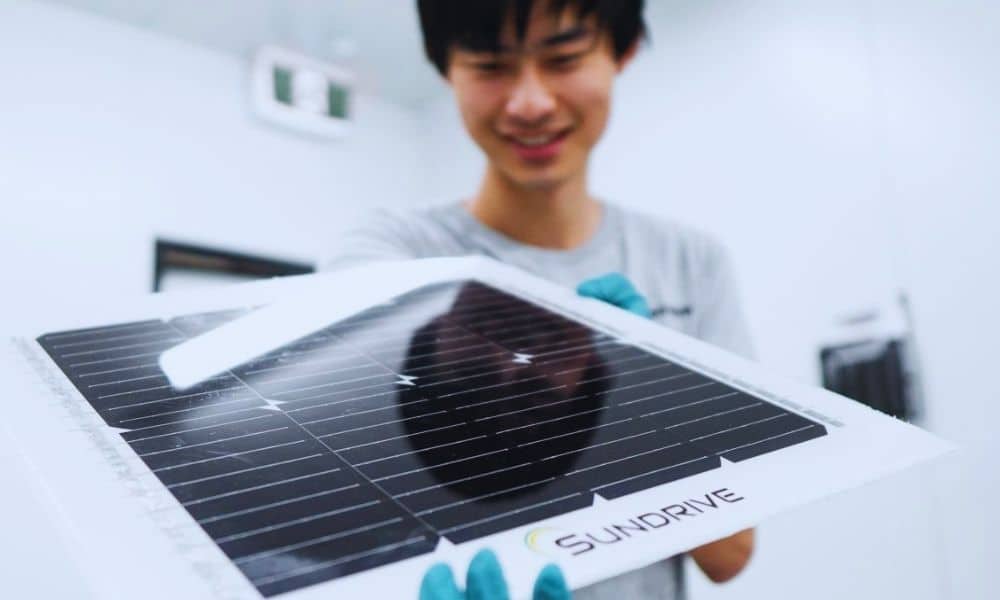In what has been described as a “major milestone”, Australian start-up SunDrive has announced a new full area commercial solar cell efficiency record of 26.07 per cent. The news, shared via the company’s LinkedIn page, is the latest in a recent spate of solar cell efficiency records set by the young company, taking on some of the world’s largest solar manufacturers in the process.

“A huge moment for the team”
With tech billionaire Mike Cannon-Brookes backing the company, SunDrive is quickly making a name for itself as a serious player in the global solar cell industry. The solar technology start-up was founded in 2015 by UNSW graduates Vince Allen and David Hu. From humble beginnings in a garage in Sydney’s eastern suburbs, SunDrive now aims to produce low-cost, high-efficiency solar cells locally and is optimistic that they can compete with large solar manufacturers in Asia.
And they are well on their way.
Just a few months ago, SunDrive set a new world record for a commercial-size silicon solar cell, with an efficiency of 25.54 per cent, overtaking the previous record held by multi-billion dollar Chinese solar giant Longi. The cell is also silver-free, replacing the expensive metal with much more abundant and cheap copper.
This latest record of 26.07 per cent further cements SunDrive’s place as a world leader in solar cell efficiency.
“SunDrive is proud to announce that we have successfully reached another major milestone by surpassing the 26% efficiency mark for a full area commercial size solar cell,” the company said in its LinkedIn posting.
“A huge moment for the team as we continue to push the boundaries of what’s possible.”

Copper revolutionary for solar cell efficiency and cost
In another LinkedIn post on Thursday, Sundrive Co-Founder, Vince Allen, shared that traditional PERC solar cell technology was never designed to scale to the demand that we will require in the near future.
“There is a misconception solar is solved. Today’s solar technology is at its efficiency and material limits, yet we are only 1% of the way there in creating a solar electric world”, he said.
A significant contributing factor of this limitation is down to the materials that are used – particularly silver which is expensive and limited in supply. In swapping out silver for copper in their newly developed solar cells, SunDrive claims that you will be able to generate more power per square meter on your rooftop at a lower cost.
“Copper is a hundred times cheaper per kilogram and a thousand times more abundant than silver. We have also found we can improve the efficiency above and beyond what is found in silver.”
Allen said the production of high-efficiency solar cells at low cost is increasingly important as we move towards emerging technologies such as solar battery storage, electric vehicles and the electrification of “everything”.

The race towards ultra low-cost solar and “Solar 30 30 30”
In 2020, the Australian Renewable Energy Agency (ARENA) awarded SunDrive with a $9 million grant to develop a “new breed” of solar cells designed for Australian rooftops – a goal that the company is well on its way to achieving.
Since then, the focus on increasing the efficiency and driving down the cost of solar has taken on a new urgency as the world moves towards a carbon zero future.
Last year ‘ultra low-cost solar’ was added as a priority technology in the Australian Government’s latest Low Emissions Technology Statement (LETS), with a stretch goal to reduce the cost of utility scale solar electricity to $15 per megawatt hour.
The Australian Renewable Energy Agency’s (ARENA) 2021 Investment Plan has also set an ambitious target of 30 per cent module efficiency and 30 cents per installed watt at utility scale by 2030 – dubbed Solar 30 30 30.
In an effort to accelerate the road to ultra low-cost solar, ARENA announced a further $40 million in solar R&D funding. The funding round opened for expressions of interest in February 2022. Applications close 5pm AEST Monday 11 April 2022.
Looking to go solar? We can help!
One of the most effective ways that you can reduce your carbon footprint is to make the switch to renewable energy. Installing rooftop solar panels not only saves you money on your energy bills, but also helps reduce the demand for dirty coal-fired power. A standard 6.6kw solar system will produce around 10,600 kwh a year which will save around 10.6 tonnes of CO2 emissions per year
Energy Matters has assisted over 30,000 Australians in their transition to clean energy. We can guide you toward solar and/or battery storage solution that fits your lifestyle and budget. Receive up to 3, obligation-free solar quotes from our trusted network of accredited solar installers. It’s fast, free, and takes the hassle out of shopping around.












































